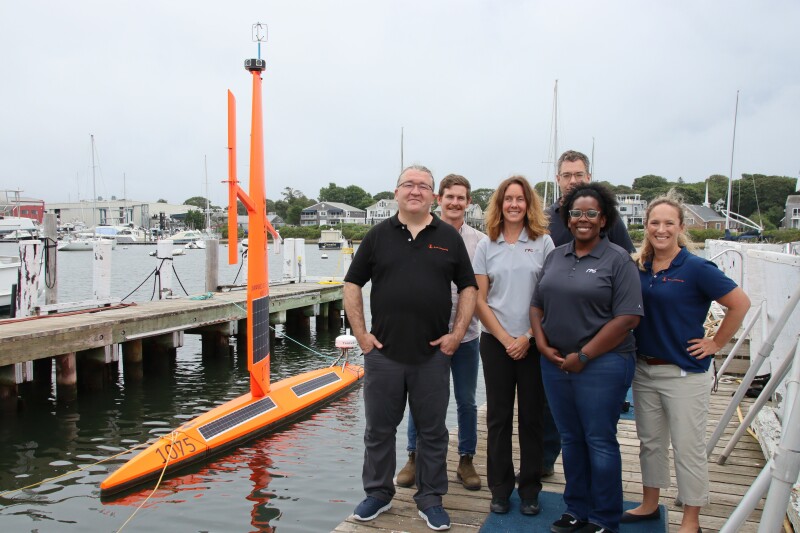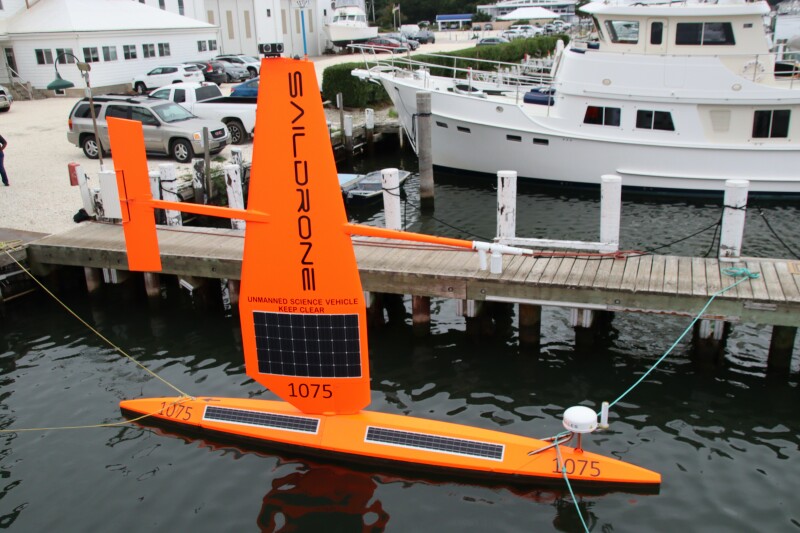Saildrone’s autonomous sea vehicles are at work off New England, tracking marine mammal movements and help design proposed offshore wind energy turbine projects.
Alameda, Calif., based Saildrone and its partners RPS, Houston, Texas, and the National Offshore Wind Research & Development Consortium (NOWRDC) hosted WorkBoat at Falmouth, Mass., Aug. 29 to get a closer look at the sail vehicles now cruising.
As I thought about the event and the three businesses involved it reminded me of an old Beatles song, “Come Together.” The verse goes like this: “One and one and one is three, got to be good looking cause she’s so hard to see.”
Every year NOWRDC posts request for proposals (RFPs) looking for new and different technologies to solve specific problems. One request sought was solutions to protect marine mammals.
Offshore wind turbine projects are underway from southern New England to Virginia, waters where humpback whale numbers have grown in recent years. Offshore wind critics tie humpback whale deaths on Mid-Atlantic beaches to survey vessels working on wind power leases and cable routes, a debate with government agencies saying there is no link to whale deaths that are casualties of ship strikes.
There could be more risk to the highly endangered North Atlantic right whale population – now estimated at only around 340 animals, often swimming around the offshore New England wind power areas.
Saildrone engineers wondered how they could put more hydrophones out there to protect marine mammals in areas of offshore wind. On Sept. 15, 2022, RDC announced Saildrone as one of two new ocean area projects to monitor protected marine mammals and design floating arrays.
"We release and administer government and industry funds for research and development,” says Julian Fraize, program manager at NOWRDC. “Specifically, R&D aims to lower the cost associated with responsible development of U.S. offshore wind."
Stephanie Milne, team leader, U.S. offshore renewables/senior environmental manager of RPS, says some of the problems she tries to solve in offshore wind industry are the same found in the oil and gas industry. RPS is a leading provider of protected species monitoring and mitigation compliance services.
“We have lots of boats moving around,” Milne says. “We want to make sure we don’t run into animals. And when we make a lot of noise, we want to make sure we’re not impacting the animals negatively.” Her job involves putting marine mammal biologists on boats with big footprints. She knows, however, there is another way for them not to be out there in an unsafe environment.
Saildrone asked Milne if they provided the data for the biologists, could they monitor the data from remotely home?
They were hoping for a USV with a hydrophone array on it. Then, collect and stream the acoustic data for people to listen to or watch for marine mammals. A plus would be collecting the data from a nice, quiet platform at sea – an ideal setup for monitoring a site, for example during pile driving for big turbine foundations during construction.
Saildrone believed they could find a solution for Milne to keep her biologists off the big boats. The companies formed a partnership and sent in their proposal for NOWRDC.
Tasha Smith, environmental technology manager for RPS, said she is also excited about the partnership with Saildrone. Her group is creating their own artificial intelligence software to detect and help mitigate and monitor protected species. “We’re trying to figure out the best way to incorporate this software with Saildrone,” says Smith.
The AI software detects whether there is marine life in the area or if it is a ship, for example. They still require a human to listen while the AI learns its role. RPS has their own large database of various sounds they use to confirm their AI’s information.
“What we have here is our passive acoustic array,” says Brian Hernacki, chief technology officer for Saildrone. “It is a multifrequency multipurpose commercial acoustic array designed for sensing a variety of phenomena specifically focused on marine mammal and vessel detection.” You can deploy this combination of flexible array on a quiet, cost-effective USV. Plus, it can monitor events 24/7.
This drone is purely solar- and wind-powered. The battery array inside, built by Saildrone’s team, gives them a longer duration at sea. The computer systems power the satellite transmission systems from the battery. This particular model mainly sails on wind which means it doesn’t need a large amount of battery power to do that.
What makes this partnership a success? “It’s the ability to deploy a vehicle for months at a time on just solar power,” says Jim Morash, Saildrone’s electrical team lead. “Plus, the consistency of collecting data.”
The drone was waiting to come out of the water at South Falmouth and be shipped back to California to extract the data.




